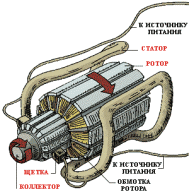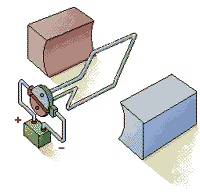Categories: Featured Articles » Novice electricians
Number of views: 336518
Comments on the article: 5
The device and principle of operation of a simple electric motor
An electric motor is simply a device for efficiently converting electrical energy into mechanical energy.
This transformation is based on magnetism. Electric motors use permanent magnets and electromagnets, in addition, they use the magnetic properties of various materials to create these amazing devices.
There are several types of electric motors. We note two main classes: AC and DC.
Class AC motors (Alternating Current) require an AC or voltage source to operate (you can find such a source in any electrical outlet in the house).
Electric motors of DC (Direct Current) class require a direct current or voltage source to operate (you can find such a source in any battery).
Universal engines can work from any type of source.
Not only the design of the engines is different, the methods of controlling speed and torque are different, although the principle of energy conversion is the same for all types.
Electric motors are used everywhere. Even at home you can find a huge number of electric motors. Electric motors are used in watches, in a microwave oven fan, in a washing machine, in computer fans, in an air conditioner, in a juicer, etc., etc. Well, electric motors used in industry can be listed endlessly. The physical dimensions range from the size of a match head to the size of a locomotive engine.
The industrial electric motor shown below operates on both direct and alternating current. Its stator is an electromagnet that creates a magnetic field. The motor windings are alternately connected via brushes to a power source. One by one, they rotate the rotor a small angle, and the rotor rotates continuously.
Industrial electric motor
The simplest electric motor
The simplest electric motor works only on direct current (from the battery). Current flows through a frame located between the poles of a permanent magnet. The interaction of the magnetic fields of the frame with the current and the magnet causes the frame to rotate. After each half-turn, the collector switches the frame contacts suitable for the battery, and therefore the frame rotates.
See also at e.imadeself.com
:


